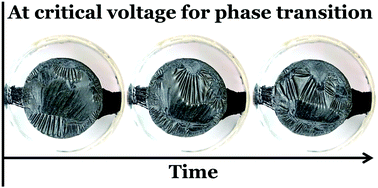Dynamic pattern of wrinkles in a dielectric elastomer†
Abstract
A membrane of a dielectric elastomer may undergo electromechanical phase transition from the flat to wrinkled state, when the applied voltage reaches a critical value. The wrinkled region is observed to expand at the expense of the flat region during the phase transition. In this paper, we report on a dynamic pattern of wrinkles in a circular membrane of a dielectric elastomer. During phase transition, both the flat and wrinkled regions move interchangeably in the membrane. The radial prestretch is found to significantly affect electromechanical phase transition. For example, a membrane with a small prestretch can exhibit a dynamic pattern of wrinkles, which is essentially related to snap-through instability. However, a membrane with a large prestretch undergoes continuous phase transition, without exhibiting a dynamic pattern. An analytical model is developed to interpret these experimental phenomena. Finite element simulations are performed to predict the wrinkle morphology, especially the coexistence of flat and wrinkled regions. Both the theoretical calculations and finite element simulations are qualitatively consistent with the experiments. Additionally, we observe another type of electromechanical behavior involving a dynamic pattern of wrinkles with different wavelengths. The membrane first undergoes continuous transition from the flat to wrinkled state, followed by discontinuous transition from one wrinkled state to another. These results may inspire new applications for dielectric elastomers such as on-demand patterning of wrinkles for microfluidics and stretchable electronics.



 Please wait while we load your content...
Please wait while we load your content...